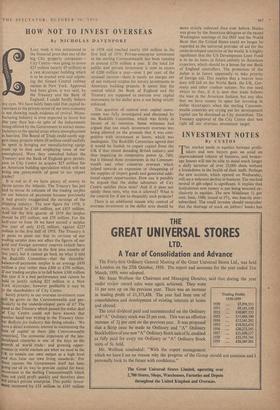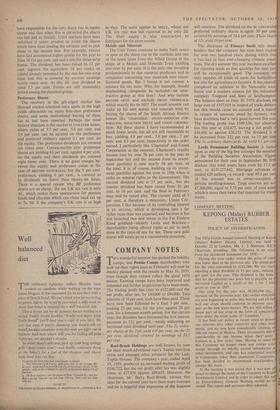INVESTMENT NOTES
By CUSTOS MHE market tussle in equities between profit- ' takers and new buyers goes on amid an unprecedented volume of business, and broker- age houses will not be able to stand much longer a daily turnover of over 25,000 deals without a breakdown in the health of their staffs. Perhaps the new account, which opened on Wednesday, will see a welcome decline in business. The marked revival in gilt-edged is significant. It implies that institutional new money is not being invested ex- clusively in equities. The new Middlesex 51 per cent. loan, 1980, issued at 971, was heavily over- subscribed. The small investor should remember that the shortage of stock on jobbers' books has been responsible for the very sharp rise in equity shares and that when this is corrected the shares can fall just as sharply. Until markets have been stabilised it seems prudent to avoid the shares which have been leading the advance and to pick those in the second line. For example, FISONS have just announced higher profits for the year to June 30 (16 per cent. up) and a one-for-three scrip bonus. The dividend has been raised to 12 per cent. (against the equivalent 10 per cent.) on capital already increased by the one-for-two scrip issue and this is covered by current earnings nearly twice over. At 68s. 6d. cum dividend to yield 3.5 per cent. Fisons are still reasonably priced among the chemical group.
Preference Shares
The recovery in the gilt-edged market has directed market attention once again to the high yields obtainable on many first-class preference shares, and some institutional buying of them has at last been reported. Perhaps the most bizarre situation is the market in UNILEVER issues, where yields of 5.7 per cent., 5.8 per cent. and 5.9 per cent, can be secured on the preference and preferred ordinary against 2.1 per cent, on the equity. The preference dividends are covered ten times over. CONSOLIDATED ZINC preference shares are yielding 6+ per cent. against 4 per cent. on the equity and their dividends are covered eight times over. There is no great margin be- tween the equity and preference yields in the case of BRITISH PETROLEUM, but the 9 per cent. preference, yielding 6 per cent., is covered as to dividends no fewer 'than twenty-six times. There is a special reason why BP preference shares are so cheap: the net UK tax rate is only 4d., which makes them unattractive for pension funds and charities which can claim back tax up to 7s. 9d. if the company's UK rate is as high as that. The same applies to SHELL, whose net UK tax rate was last reported to be only 2d. The Shell equity' is also unattractive to foreigners for the same reason.
Metals and Minerals
The Unit Trusts continue to make fresh issues in spite of the sharp rise in the markets, and one of the latest came from the Allied Group in the shape of a Metals and Minerals Trust yielding just over 4+ per cent. It is the only one investing predominantly in raw material producers and in companies converting raw materials into manu- factured goods. But I found it too curious a mixture for my taste. Why, for example, should shipbuilding companies be included-an unat- tractive group at this time? And why include BRITISH GLUE and exclude GREEF CHEMICALS, which exactly fits its bill? The small investor can make up his own metals and minerals trust by buying the shares of the South African finance houses like 'CHARTERED.' ANGLO-AMERICAN COR- PORATION, SELECTION TRUST and UNION CORPORA- TION. All these shares I have recommended at much lower levels, but all are still reasonable to buy, yielding 4.9 per cent., 3.8 per cent., 5 per cent. and 4.3 per cent, respectively in the order named. I particularly like 'Chartered' and Union Corporation at the moment. Chartered's royalty income rose by over 50 per cent. in the year to September last and the income from its invest- ment portfolio is now nearly 30 per cent, of the total. It is, of course, building up its invest- ment portfolio against the time in 1986 when it cedes its mineral rights to the Government. The current dividend rate is 35 per cent., but the interim dividend has been raised from 8+ per cent. to 10 per cent. and the final in February may well be raised also. The current yield of 5 per cent. is therefore a minimum. Union Cor- poration I like because of its controlling interest in ST. HELENA, which is developing into a far richer mine than was expected, and because it has just launched two new mines in the Far Eastern Rand goldfield-namely Leslie and Bracken- shareholders being offered rights at par in each mine in the ratio of one for ten. These new gold shares will surely go to a considerable premium.











































 Previous page
Previous page